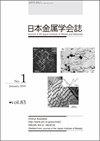Strengths and Microstructure of SUS316L Fabricated by Selective Laser Melting
IF 0.4
4区 材料科学
Q4 METALLURGY & METALLURGICAL ENGINEERING
引用次数: 7
Abstract
The additive manufacturing (AM) process, which can produce highly complex components, has been getting signi cant attention in both industry and academic research. Ti-based alloys, Ni-based superalloys, and Co-Cr-based alloys have been widely investigated. However, as Ni-based superalloys have precipitated phases such as the γ′ and γ′′ phases, and Ti-based alloys and Co-Cr-based alloys are multiphase alloys which have phase transformation, it is dif cult to clarify the factors in the AM process that in uence the strength of these alloys. In this study, SUS316L stainless steel, which is a single-phase solid-solution alloy and does not have precipitated phases, was used to investigate the effect of speci c factors in the AM process on anisotropy or mechanical properties, and the strengthening mechanism in the AM process in comparison with SUS316L plastic-forming (PF) material. The AM SUS316L was fabricated by selective laser melting using an ytterbium ber laser from ne metallic powder. We found that the coarse columnar grains grew up along the built direction and the dislocation cell structures which were induced during the AM process into the AM material. During the solution heat treatment, dislocation recovery was observed. The AM specimens showed higher tensile and creep strength compared with the conventional material (the PF material) because of the high dislocation density. The ductility of the AM specimens was lower than that of the conventional material because of defects caused by a lack of fusion at the molten pool boundaries. Furthermore, the specimens whose loading direction corresponds to the built direction showed lower strength and elongation than the specimens whose loading direction was perpendicular to the built direction due to the oriented defects. [doi:10.2320/matertrans.M2017163]选择性激光熔化制备SUS316L的强度和显微组织
增材制造(AM)工艺可以生产高度复杂的部件,在工业界和学术界都受到了极大的关注。ti基合金、ni基高温合金和co - cr基合金得到了广泛的研究。然而,由于ni基高温合金存在γ′和γ′相等析出相,而ti基合金和co - cr基合金是多相合金,具有相变,因此在AM过程中影响这些合金强度的因素很难明确。本研究以不存在析出相的单相固溶合金SUS316L不锈钢为研究对象,研究增材制造过程中特定因素对其各向异性或力学性能的影响,以及增材制造过程中与SUS316L塑性成形(PF)材料相比的强化机理。以金属粉末为原料,采用选择性激光熔融法制备了AM SUS316L合金。结果表明,在AM过程中,AM材料中出现了沿构建方向生长的粗柱状晶粒和位错胞结构。固溶热处理过程中,观察到位错恢复。与常规材料(PF材料)相比,AM材料具有较高的位错密度,具有较高的拉伸和蠕变强度。增材制造试样的延展性低于常规材料,这是由于熔池边界处缺乏熔合而导致的缺陷。同时,由于取向缺陷的存在,加载方向与构建方向相对应的试件的强度和伸长率低于加载方向与构建方向垂直的试件。(doi: 10.2320 / matertrans.M2017163)
本文章由计算机程序翻译,如有差异,请以英文原文为准。
求助全文
约1分钟内获得全文
求助全文
来源期刊

Journal of The Japan Institute of Metals
工程技术-冶金工程
CiteScore
0.70
自引率
0.00%
发文量
27
审稿时长
6-12 weeks
期刊介绍:
Information not localized
 求助内容:
求助内容: 应助结果提醒方式:
应助结果提醒方式:


